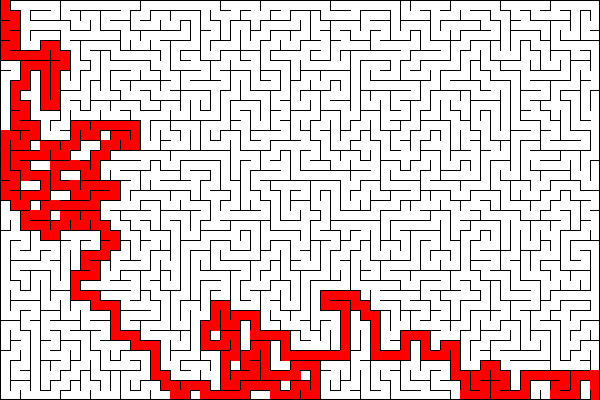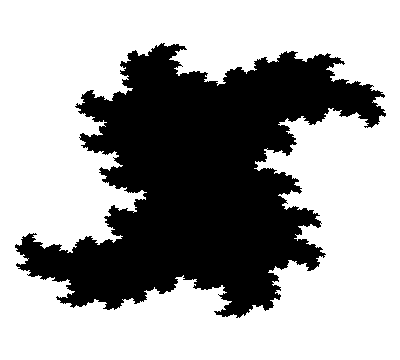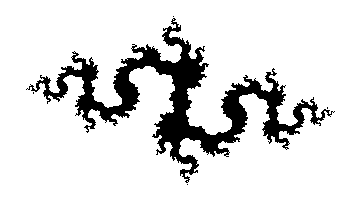A chi mi obietta – ingiustamente – che ai tempi non era disponibile un interprete Perl così come un notebook agevolmente trasportabile in un Labirinto, ma anche a tutti gli altri che gridano vendetta contro il comportamento di Téseo nei confronti della povera Arianna, consiglio vivamente la lettura dell’avvincente leggenda del Minotauro; scoprirete che la storia di Téseo, per opera di Poseidone, si conclude in modo tragico a causa dell’inversione di un’informazione booleana (1 bit) ma vitale: il colore delle vele della sua imbarcazione.
Dopo questa mitologica premessa, certo di esser perdonato per eventuali errori sulla mitologia greca, sperando di non deludere il forse unico temerario lettore che avrà avuto l’ardore di proseguire nella lettura di questo articolo, vi presento un semplicissimo generatore e risolutore di labirinti scritto interamente in Perl.
In rete esistono anche molti riferimenti sui labirinti (storia, classificazione, generazione, risoluzione, miti e leggende) dove è piacevole perdersi:
Nella mia implementazione, esaltando alcune caratteristiche tipiche del Perl, ho progettato delle strutture dati leggere ed efficienti (memorizzo solo le aperture del labirinto) ed ho adottato la versione dell’algoritmo depth-first search ricorsiva sia per la costruzione del labirinto (metodo Maze::asterione) che per la ricerca del percorso che conduce dall’ingresso all’uscita (metodo Maze::teseo).
Per la generazione dell’immagine si richiedono le librerie GD.
Il tutto sarebbe ottimizzabile e migliorabile ma al momento sono già abbastanza soddisfatto dei risultati ottenuti!
#!/usr/bin/perl
use strict;
use warnings;
package Maze;
use Carp qw(croak verbose);
use GD;
sub new {
my ($class, $x, $y) = @_;
my $self = {
x => $x,
y => $y,
doors => [],
solution => [],
};
bless $self;
$self->openWall(0, 0, 'N');
$self->openWall($x - 1, $y - 1, 'S');
return $self;
}
sub _getWallIndex($$$){
my ($self, $x, $y, $dir) = @_;
my @idx =
$dir eq 'N' ? ($x, $y, 'N') :
$dir eq 'S' ? ($x, $y + 1, 'N') :
$dir eq 'W' ? ($x, $y, 'E') :
$dir eq 'E' ? ($x + 1, $y, 'E') :
croak "wrong direction";
return @idx;
}
sub isWallOpen($$$){
my ($self, $x, $y, $dir) = @_;
my ($wx, $wy, $wdir) = $self->_getWallIndex($x, $y, $dir);
return $self->{door}[$wx][$wy]{$wdir} || 0;
}
sub openWall($$$) {
my ($self, $x, $y, $dir) = @_;
my ($wx, $wy, $wdir) = $self->_getWallIndex($x, $y, $dir);
$self->{door}[$wx][$wy]{$wdir} = 1;
}
sub getCellNeighbors($$$){
my ($self, $x, $y) = @_;
grep {
$_->[0] >= 0 and $_->[0] < $self->{x} and
$_->[1] >= 0 and $_->[1] < $self->{y}
} (
[$x - 1, $y , 'W'],
[$x + 1, $y , 'E'],
[$x , $y - 1, 'N'],
[$x , $y + 1, 'S']
);
}
sub getCellOpenedNeighbors($$$){
my ($self, $x, $y) = @_;
grep {
my (undef, undef, $dir) = @$_;
$self->isWallOpen($x, $y, $dir)
} $self->getCellNeighbors($x, $y);
}
sub isCellExit($$$){
my ($self, $x, $y) = @_;
return
($x == $self->{x} -1 ) && ($y == $self->{y} -1 );
}
sub markSolution($$$){
my ($self, $x, $y) = @_;
$self->{solution}[$x][$y] = 1;
}
sub isSolution($$$){
my ($self, $x, $y) = @_;
$self->{solution}[$x][$y];
}
# generate maze
sub asterione($$$$){
no warnings 'recursion';
my ($self, $x, $y, $visited) = @_;
$visited->[$x][$y] = 1;
return if $self->isCellExit($x,$y);
my @neighbors = $self->getCellNeighbors($x, $y);
while (scalar @neighbors){
my ($tox, $toy, $dir) =
@{ splice(@neighbors, rand(@neighbors), 1) };
next if $visited->[$tox][$toy];
$self->openWall($x, $y, $dir);
$self->asterione($tox, $toy, $visited);
}
}
# solve maze
sub teseo($$$$){
no warnings 'recursion';
my ($self, $x, $y, $visited) = @_;
$visited->[$x][$y] = 1;
if ($self->isCellExit($x, $y)){
$self->markSolution($x, $y);
return 1;
}
my @neighbors = $self->getCellOpenedNeighbors($x, $y);
while (scalar @neighbors){
my ($tox, $toy, $dir) =
@{ splice(@neighbors, rand(@neighbors), 1) };
next if $visited->[$tox][$toy];
my $isSolution = $self->teseo($tox, $toy, $visited);
if ($isSolution){
$self->markSolution($x, $y);
return 1;
}
}
return 0;
}
sub toText(){
my $self = shift;
my ($x, $y, @l1, @l2);
my $out = '';
for ($y = 0; $y < $self->{y}; $y++){
@l1 = @l2 = ();
for ($x = 0; $x < $self->{x}; $x++){
my $solution = $self->isSolution($x, $y) ? '.' : ' ';
push(@l1, $self->isWallOpen($x, $y, 'N') ? $solution x 2 : '-' x 2);
push(@l2, $self->isWallOpen($x, $y, 'W') ? ' ' : '|');
push(@l2, $solution x 2);
}
push(@l2, $self->isWallOpen($x, $y, 'E') ? ' ' : '|');
$out .=
'+' . join('+',@l1) . '+' . "\n" .
join('',@l2) . "\n";
}
@l1 = ();
for ($x = 0; $x < $self->{x}; $x++){
my $solution = $self->{solution}[$x][$self->{y} -1] ? '.' : ' ';
push(@l1,
$self->isWallOpen($x, $self->{y} -1, 'S') ?
$solution x 2 : '-' x 2
);
}
$out .= '+' . join('+', @l1) . '+' . "\n";
print $out;
}
sub toImage($$){
my ($self, $FILENAME) = @_;
my ($WX, $WY) = (10, 10);
my ($SIZEX, $SIZEY) = ($self->{x} * $WX, $self->{y} * $WY);
my $img = new GD::Image->newTrueColor($SIZEX,$SIZEY)
or croak "Can't create GD::Image";
my $cl_white = $img->colorAllocate(255,255,255);
my $cl_black = $img->colorAllocate( 0, 0, 0);
my $cl_red = $img->colorAllocate(255, 0, 0);
$img->fill( 0, 0, $cl_white);
open(my $fh, '>', $FILENAME)
or croak "Can't open $FILENAME: $!";
binmode $fh;
my ($xx, $yy);
YY: for ($yy = 0; $yy < $self->{y}; $yy++){
XX: for ($xx = 0; $xx < $self->{x}; $xx++){
$img->filledRectangle(
$xx * $WX, $yy * $WY, ($xx + 1) * $WX, ($yy + 1) * $WY,
$cl_red
)
if $self->isSolution($xx, $yy);
$img->line(
$xx * $WX, $yy * $WY, ($xx + 1) * $WX, $yy * $WY,
$cl_black
)
unless $self->isWallOpen($xx, $yy, 'N');
$img->line(
$xx * $WX, $yy * $WY, $xx * $WX, ($yy + 1) * $WY,
$cl_black
)
unless $self->isWallOpen($xx, $yy, 'W');
}
$img->line(
$xx * $WX - 1, $yy * $WY, $xx * $WX -1, ($yy + 1) * $WY,
$cl_black
)
unless $self->isWallOpen($xx - 1, $yy, 'E');
}
for ($xx = 0; $xx < $self->{x}; $xx++){
$img->line(
$xx * $WX, $yy * $WY - 1, ($xx + 1) * $WX, $yy * $WY - 1,
$cl_black
)
unless $self->isWallOpen($xx, $yy - 1, 'S');
}
print $fh $img->png(0);
close $fh;
}
package main;
# init
my $m = Maze->new(60,40);
# generate paths
$m->asterione(0,0,[]);
# solve maze
$m->teseo(0,0,[]);
# generate PNG
$m->toImage('out.png');
# print ASCII
#$m->toText();













